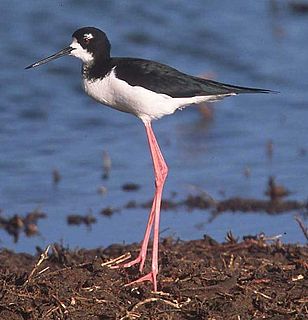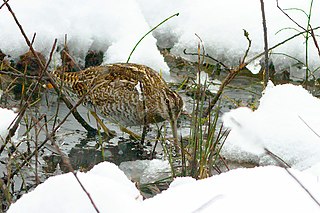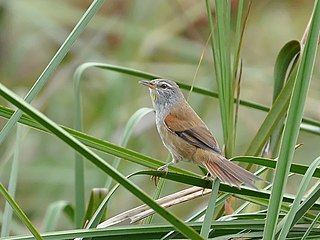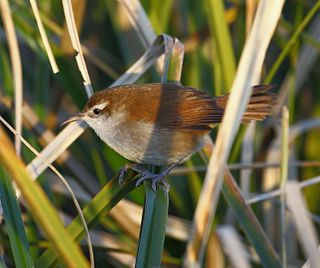Related Research Articles

The fish crow is a species of crow associated with wetland habitats in the eastern and southeastern United States.

The Recurvirostridae are a family of birds in the wader suborder Charadrii. It contains two distinct groups of birds, the avocets and the stilts.

Ovenbirds or furnariids are a large family of small suboscine passerine birds found from Mexico and Central to southern South America. They form the family Furnariidae. The ovenbird, which breeds in North America, is not a furnariid – rather it is a distantly related bird of the wood warbler family, Parulidae.

The long-billed dowitcher is a medium-sized shorebird with a relatively long bill belonging to the sandpiper family, Scolopacidae. In breeding plumage, adults are characterized by a beautiful rufous head and underparts with a darker mottled back and a large white upper rump only seen in flight. They feed in various freshwater habitats with their bill underwater in a "sewing machine" motion and are known to have an exciting mating display where males chase females in flight. The genus, Limnodromus is Ancient Greek from limne, "marsh" and dromos, "racer". The specific scolopaceus is New Latin for "snipe-like", from Latin scolopax, scolopacis, a snipe or woodcock. The English name is from Iroquois and was first recorded in 1841.

The black-tailed godwit is a large, long-legged, long-billed shorebird first described by Carl Linnaeus in 1758. It is a member of the godwit genus, Limosa. There are three subspecies, all with orange head, neck and chest in breeding plumage and dull grey-brown winter coloration, and distinctive black and white wingbar at all times.

The spotted crake is a small waterbird of the family Rallidae. The scientific name is derived from Venetian terms for small rails.

The curve-billed thrasher is a medium-sized mimid native to the deserts of the southwestern United States and much of Mexico. It is a non-migratory species, and throughout most of its range it is the most common desert thrasher. Several subspecies have been classified since 1827, though there is no consensus on the number. Allopatric speciation is believed to have played a major role in the variations of the curve-billed. It is grey-brown overall with a slightly curved bill, and is similar in appearance to the related Bendire's thrasher. It generally resides in desert regions of the United States and Mexico, but can inhabit areas predominately populated by humans.

Epimachus is a genus of birds-of-paradise (Paradisaeidae) that includes two species, found in the highland forests of New Guinea. They are the largest members of the family. The common name "sicklebill" refers to their long, decurved, sickle-shaped bill.
Palaeocursornis is a monotypic genus of pterosaurs. The only known species, P. corneti, was described in 1984 based on a single bone interpreted as the distal part of a left femur, found in Early Cretaceous (Berriasian rocks from a mine at Cornet near Oradea in northwestern Romania. It was initially assumed to be a flightless paleognathe bird, possibly a ratite, and later as a more primitive ornithuromorph or non-avialan theropod. However, re-evaluation of the specimen suggested that it was not a femur at all, but the upper arm bone of a pterodactyloid pterosaur similar to Azhdarcho.

The African snipe also known as the Ethiopian snipe, is a small stocky wader. It breeds in eastern and southern Africa in wet mountain moorland and swamps at altitudes of 1,700–4,000 m (5,600–13,100 ft). When not breeding it disperses widely, including into coastal lowlands.

The Madagascan snipe is a small stocky wader. It breeds only in the humid eastern half of Madagascar, from sea-level up to 2,700 m, being more common above 700 m. It is non-migratory.

The solitary snipe is a small stocky wader. It is found in the Palearctic from northeast Iran to Japan and Korea.

The sulphur-bearded reedhaunter is a species of non-migratory bird in the family Furnariidae. It is found in the Pampas and adjacent areas of eastern Argentina and Rio Grande do Sul. Its natural habitat is swamps.

The straight-billed reedhaunter is a South American bird species in the family Furnariidae.

Limnoctites is the genus of reedhaunters, birds in the family Furnariidae. It contains the following species:

The curve-billed reedhaunter is a species of bird in the family Furnariidae. It is found in marshy areas of north-eastern Argentina, south-eastern Brazil, and Uruguay. It occupies a similar ecological niche to some reed warblers.

The black-tailed leaftosser is a species of bird in the family Furnariidae. It is found in Bolivia, Brazil, Colombia, Ecuador, French Guiana, Guyana, Peru, Suriname, and Venezuela. Its natural habitat is tropical moist lowland forests.

Edmontosaurus annectens is a species of flat-headed and duck-billed (hadrosaurid) dinosaur from the very end of the Cretaceous Period, in what is now North America. Remains of E. annectens have been preserved in the Frenchman, Hell Creek, and Lance Formations. All of these formations are dated to the late Maastrichtian stage of the Late Cretaceous Period, representing the last three million years before the extinction of the dinosaurs. Also, E. annectens is also from the Laramie Formation, and magnetostratigraphy suggests an age of 69-68 Ma for the Laramie Formation. Edmontosaurus annectens is known from numerous specimens, including at least twenty partial to complete skulls, discovered in the U.S. states of Montana, South Dakota, North Dakota, Wyoming and Colorado and the Canadian province of Saskatchewan. It was a large animal, up to approximately 12 metres (39 ft), potentially up to 15 m (49 ft) in length, with an extremely long and low skull. E. annectens exhibits one of the most striking examples of the "duckbill" snout common to hadrosaurs. It has a long taxonomic history, and specimens have at times been classified in the genera Diclonius, Trachodon, Hadrosaurus, Claosaurus, Thespesius, Anatosaurus and Anatotitan, before being grouped together in Edmontosaurus.

Durrell's vontsira is a Madagascan mammal in the family Eupleridae of the order Carnivora. It is most closely related to the brown-tailed mongoose, with which it forms the genus Salanoia. The two are genetically similar, but morphologically distinct, leading scientists to recognize them as separate species. After an individual was observed in 2004, the animal became known to science and S. durrelli was described as a new species in 2010. It is found only in the Lac Alaotra area.
References
- ↑ Olson, S. L., M. Irestedt, P. G. P. Ericson, & J. Fjeldså. 2005. Independent evolution of two Darwinian marsh-dwelling ovenbirds (Furnariidae: Limnornis, Limnoctites). Ornitologia Neotropical 16: 347-359.